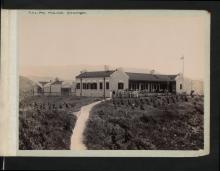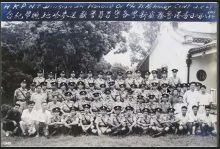Current condition
In use
Date completed
This is one of the buildings under the Government's 'Revitalisation Scheme'. The selected project is "The Green Hub for sustainable living", by the Kadoorie Farm and Botanic Garden Corporation.
Some highlights:
- Restoring the original architectural characteristics of the buildings and replace outbuildings with theme-gardens to bring the courtyard back to life;
- Minimising architectural additions and use the buildings to serve similar functions as if they were in the old days, for example, the Canteen Block will host a canteen to promote a low-carbon diet; the bedrooms at the Main Building will support the educational programmes and training camps; the original outlook of the Cell and Amory will be preserved as part of a heritage exhibition and trail;
They also plan major work on the "neglected gardens of the site". Work is estimated to be finished in the second half of 2013.
More information:
- Background on the site
- Heritage website reports project winner
- Kadoorie Farm website report on project
Links via Guy Shirra.



Comments
Re: Former Tai Po Police Station
Heritage Impact Assessment can be viewed at http://www.amo.gov.hk/form/OTPPS-HIA.pdf
1st Battle of Tai Po
A very little known part of Hong Kong's history was the violent resistance to the British occupation of the New Territories in 1899. Dismissed by the British as a couple of scuffles the quoted article shows that it was much more than that. I have placed the account under the Ping Shan & Tai Po Police Stations, the Lam Tsuen valley & Sham Chun as these were the key locations during during the conflict
The Tensions at Ping Shan Police Station is here
The first confrontation between the Ts'at Yeuk and the vanguard of the occupying force occurred at Tai Po. Since late March, contractors had been erecting matsheds for the Hong Kong authorities on a hill near the market. Work had been obstructed by local villagers who claimed that the hill was private land and that the matsheds would disturb the feng shui of the area. On 3rd April Captain-Superintendent May set off for Tai Po, with a mixed party of Sikh policemen from Hong Kong and a detachment of Chinese soldiers, which had been temporarily assigned to him by the Commander of the Chinese military garrison stationed at Kowlocn City. He hoped to get work on the matsheds started again and intended to leave the soldiers as a guard for the construction materials, pending assumption of British authority in the Territory.
May arrived at Tai Po early in the afternoon and went to a nearby temple — almost certainly the Man Mo Miu — where he knew he would meet local leaders. A large crowd gathered, both within the temple and in the narrow street outside. His efforts at persuasion failed and the bystanders "became very offensive in their language and demeanour . . ," May thought it wise to leave, but hope of a dignified withdrawal ended as soon as the British party reached the street. They were set upon by an angry crowd, wielding brooms, buckets, and other improvised weapons. An escape was made after the soldiers had threatened the crowd with their rifles and the Sikhs had made a bayonet charge to clear a a path.
When the party regained their boat May sent the civilians back to Hong Kong. He took the remainder of his men to the matshed hill, where he intended to spend the night. As May deployed his men on the hillside, men from Fan Leng took the card of Man Cham-tsun — leader of the Man lineage of Tai Hang — to villages throughout the area, asking for help in an assault on his position.
When darkness fell, May could see lights in the five villages nearest the hill and more lights moving along the footpaths to the rear of his position. Bombs were exploded in the adjacent valley and parties whistled and signalled as they moved forward. Realising that he could not hold the hill, May withdrew to an adjacent one and from there watched the attack. A signal drum sounded and there was a concerted rush from all sides to the crest of the hill. The matsheds were fired and a search begun for the British party. May and his men hid in a thicket of rushes and cactus until early the next morning, when they were able to escape unobserved.
Source: Militia, Market and Lineage: Chinese Resistance to the occupation of Hong Kong's New Territories in 1899. R. G. Groves. RASHK Vol 9 (1969) p.51-52
The fight continued with a much larger battle in the Lam Tsuen Valley on the 17th & 18th April here
Occupation of Sham Chun here
history
It was used as the New Territories Police Headquarters since 1899. It was the first colonial building in the New Territories. In 1949, it was changed into a divisional police station. In 1987, the new Tai Po Divisional Police Station was opened, and it was converted into the police office of the New Territories North Regional Crime Prevention Unit. It was vacant since 2006. Although it is a vacant building, its colonial architectural features, such as verandas for cooling, shutters, double-tube double-tile roof design, Chinese-style wooden roof structure, etc., made it rated as a first-class historical building in 2009.
https://collection.news/appledaily/articles/TLIM5NYUE3RKKHOWV7V4IKFTPM